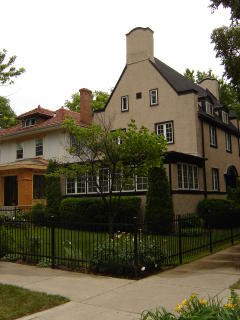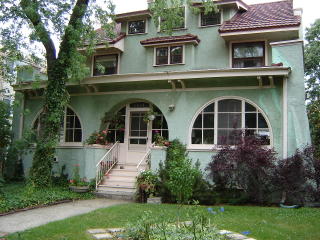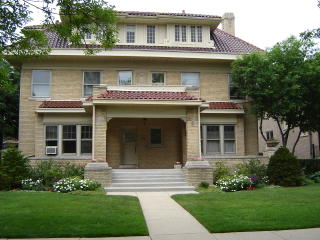(Disclaimer: I don't pretend to be an expert on architecture, just trying to learn as I go.)
I think it's safe to say this house is Tudor Revival.
 Based on English domestic architecture from the 1500s and 1600s, Tudor Revival gained great popularity as a residential style in America during the early 20th century.
Based on English domestic architecture from the 1500s and 1600s, Tudor Revival gained great popularity as a residential style in America during the early 20th century.Common characteristics are:
steeply pitched gable roofs
use of stucco, particularly in ends of gables
rounded bays and turrets
irregular massing
I'd call the below house a Spanish Revival with some Craftsman influences.
 This style is based on Spanish colonial and Mexican buildings that were built in California, Texas and the American Southwest between the early 1600s and the 1840s. The style regained popularity as a revival style during the 1920s.
This style is based on Spanish colonial and Mexican buildings that were built in California, Texas and the American Southwest between the early 1600s and the 1840s. The style regained popularity as a revival style during the 1920s.Common characteristics are:
brick or stucco walls
twisting columns and decorative shields made of terra cotta
round arched windows
elaborately rounded roof parapets based on Spanish colonial missions
clay tile roofs
 American Four Sqaure- a nice one!
American Four Sqaure- a nice one!This post-Victorian style of single-family house, prized for its ease of construction, practicality, and roomy interior, is found throughout Chicago. The largest concentrations are in community areas developed during the style's heyday (1900-1930), such as Beverly, Norwood Park, Rogers Park, and South Shore.
Common characteristics are:
cubic shape
hipped roof, usually with dormers
broad front porch, sometimes enclosed
little use of ornament
built in wide variety of materials, including wood, brick, and stucco


Renaissance Revival (I think)
This house is VERY unique. I haven't seen any other one like it anywhere in the city yet. We like to call it "The mini-Castle House."
The churches and palaces of Renaissance Italy were the inspiration for this revival style. In Chicago, it mainly was used for churches and institutional buildings, between 1890 and 1930
Common characteristics are:
round-arched windows and arcades (i.e., covered walkways or porches, formed by rows of arches resting on columns)
profusion of triangular and round-arched pediments
prominent cornices
 Of course, I can't not mention the Frank Lloyd Wright Emil Bach House. It was recently auctioned for $1million dollars.
Of course, I can't not mention the Frank Lloyd Wright Emil Bach House. It was recently auctioned for $1million dollars.
This falls under Prairie Style.
The Prairie style was developed in the late-19th and early-20th centuries by Frank Lloyd Wright and other architects as "a modern architecture for a democratic American society." Because it was largely developed in the Chicago area, this style is well represented here by some of the most important buildings of the early-20th century. Significant examples can be found in Rogers Park, Hyde Park, and Beverly.
Common characteristics are:
horizontal proportions
flat brick or stucco walls, often outlined with wooden strips of contrasting color
windows with abstract, geometric ornament
hip or gable roofs with wide, overhanging eaves
and these homes are among the reasons I love my neighborhood.
The end.

3 comments:
I think I’m going to be faint…
Those are really a pleasure to behold. I was more than a little surprised that the first two were stucco. “Chicago” and “Stucco” are 2 words I normally don’t put together – but it works in a big way! It is difficult for me to say which one I like the most. I tend to be attracted to very unique and odd things. The tall pediments (?) on the Tudor Revival, along with the under sized windows on the second story (front) of the house I find very appealing. The symmetry of the Spanish Revival house I also really like. That is just a very pleasing house to look at. What is really odd is I’m not a big fan of stucco in general but those two houses really struck me. I think my aversion to stucco has to do with the time I served (lived) in So. Ca. where there are great oceans of bland stucco housing tracts. Ugh!
I think the one I like the most is the Renaissance Revival. It is difficult to say why. I’ve really been drawn to stone buildings lately. Suzanne has been showing some amazing pictures of limestone row houses in NYC over at The Old House Web the past few days. I must go to NYC – AND Chicago!
I read once that a lot of these housing styles are in a large part due to WWI. A lot of average Americans went to Europe for the first time during the First World War and were exposed to a lot of different styles of architecture for the first time. After the war they came home and wanted a house like the ones they saw in Europe. Revival styles popped up like mushrooms here in the US.
Ooooh, prettty! My favorite is the Tudor ... I'm a big fan of that style. Until we bought our little Victorian, I daydreamed a lot about the 1920s neighborhoods near campus.
Greg- glad you liked them. I feel the same about stucco-usually not my favorite but I love the Spanish one too. It just looks like "home" to me in so many ways.
It is really interesting to know the history behind why certain types of buildings were built. I wonder what they'll say about some of the poor modern construction. Maybe it'll go like this: "And around 2002-2008 there was a huge building boom where everyone grabbed for money with no regard for the communities, people who live in them, or history and made Chicago look like downtown Dallas." Sorry, I'm on a tear this weekend. :)
Post a Comment